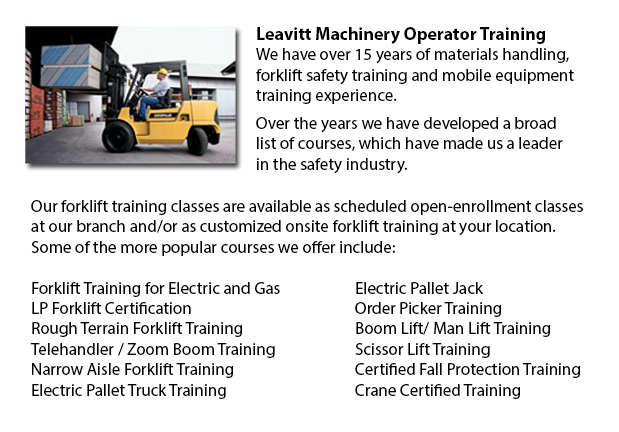
Oshawa Forklift Training Program - The lift truck is a common powered industrial vehicle that is in wide use today. They are sometimes referred to as hi los, lift trucks or jitneys. A departments store would utilize the forklift to be able to unload and load merchandise, whilst warehouses will use them to stack materials and products. And grocery stores use small models to drop supplies in the aisles. Whether transporting lumber at a sawmill or loading material at a construction site, forklift operators are needed to be correctly trained and licensed. The main concern must be on pedestrian and worker safety. This forklift training course teaches the safety and health regulations governing forklifts to be able to guarantee their efficient and safe use.
Forklift Training Program Safety Tips:
Forklift training courses are designed to guarantee that the operator is able to safely control the forklift during lifting, tilting and traveling. Only trained operators must drive a forklift.
When the forklift is in use; arms, hands, head, feet and legs should be kept inside the forklift. Lift truck forks should be kept low to the ground while being slightly tilted back. Observe posted traffic signs. Honk the horn and decrease speed if taking a corner. If the driver's vision is blocked by the load, slowly drive backwards. Pre-inspect the ground for potential hazards, such as oily or wet spots, objects, rough patches, holes, vehicles and people. Prevent stopping suddenly.
If pedestrians pass across the vehicle or moves into a blind spot, the forklift should be stopped, the load lowered, waiting until the path is clear. If a load is being transported on an incline, the forks should be pointed uphill with a load and downhill without a load. The lift truck must only be turned around when on level ground.
Safety guidelines when steering - Never turn the steering wheel sharply when traveling fast. Turn using the rear wheels and support the load by the front wheels. An overloaded truck will be hard to steer. Follow load limits. Never add a counterweight as a way to improve steering.
Safety tips when loading - Follow the recommended load and capacity limitations of the forklift. This information is displayed on the data plate. Always make certain that the load is positioned based on the suggested load centre. The forklift will remain steady so long as the load is kept close to the front wheels.
The mast of the forklift must be in an upright position before inserting the fork into a pallet. Prior to inserting the fork, level it.
-
Oshawa Scissor Lift Operator Certification
Oshawa Scissor Lift Operator Certification - North American regulators recommend that worksites need operators of scissor lifts, booms or aerial work platforms to obtain certification training. Scissor lift operator certification is not mandatory, bu... More -
Narrow Aisle Forklift / Order Picker Training / Electric Pallet Jack / Electric Pallet Truck Training in Oshawa
A pallet lift is a model of equipment dedicated in the moving of pallets of many dimensions and weights. They might be utilized as an appendage for platform lifts, cranes and other types of heavy machinery or be applied on their own. Pallet hoists ar... More -
Oshawa Crane Operator Certification
Oshawa Crane Operator Certification - The process to permit people to be able to operate certain kinds of cranes is to take crane operator certification training to get certification. The certification process incorporates classroom learning, hands-o... More -
Oshawa Aerial Platform Training
Oshawa Aerial Platform Training - Aerial platform lifts might be utilized to accomplish a lot of unique tasks executed in hard to reach aerial places. A few of the odd jobs associated with this style of lift include performing routine repair on build... More -
Oshawa Forklift Certification Schools
Oshawa Forklift Certification Schools - Forklift Certification is mandatory within North America. Hence, forklift training programs are important both for companies and for people seeking jobs in industries as forklift operators. Forklift training fo... More -
Oshawa Heavy Equipment Ticket
Oshawa Heavy Equipment Ticket - Depending on the nature of the job at hand, the type of construction equipment that a heavy equipment operator makes use of varies. Each and every type of machine is built to perform specific jobs in the most effective... More -
Oshawa Heavy Equipment Certification
Oshawa Heavy Equipment Certification - Large pieces of machines and heavy-duty vehicles are usually known as heavy equipment. This broad term includes utility vehicles from forestry and agricultural implements to civil engineering vehicles, construct... More -
Oshawa Overhead Crane Safety Training
Oshawa Overhead Crane Safety Training - The overhead crane safety training program is meant to equip the operators with the right skills and knowledge in the areas of: crane safety precautions, accident avoidance, materials handling, and equipment an... More

Forklift Certification Oshawa
TOLL FREE: 1-888-254-6157
Oshawa, Ontario
forkliftcertificationoshawa.com
Email Us
About Us


